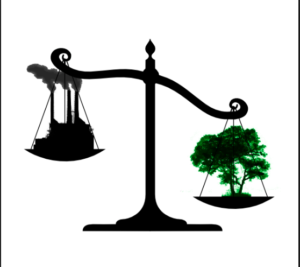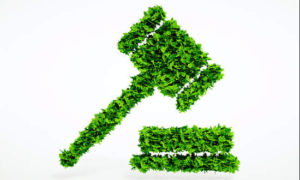At certain moments in the environmental movement, lawsuits have provided momentum to emerging legal issues. Regulation and legislation provide clear and important relief from environmental risks, but often when new risks are identified it takes time for the political class to catch up with evolving scientific knowledge and public concerns. And, of course, vested interests fight against any regulation. For example, when disposal of toxic wastes became clearly problematical for the health and environment near disposal sites in the US, there were few specific laws directly applicable for suing those responsible for the risks. But imaginative lawyers brought lawsuits founded on the historic common-law doctrine of public nuisance that prohibits encroaching upon a neighbor’s right to enjoy their own property. Eventually, laws were passed to address these risks, in the US and EU, making it easier to prosecute such claims.
We are facing one of those moments now with regard to the risks from climate emergencies. While there are global negotiations, primarily through the Intergovernmental Panel on Climate Change (IPCC), and those talks have delivered important broad-reaching targets for reducing greenhouse gas (GHG) emissions, the targets are not generally enforceable in a court of law. Nor are they sufficient to ward off the worst of the climate breakdown impacts. Some local and regional climate plans have imposed legal obligations on some sources of GHGs, but limitations often apply.

So once again the environmental community is testing the legal market for means of assessing the liability of those responsible for the GHGs that are driving climate emergencies. These recent litigation efforts are covered in a recent study by The Centre for Climate Change Economics and Policy (University of Leeds and the London School of Economics and Political Science); the Grantham Research Institute on Climate Change and the Environment (London School of Economics and Political Science); and The Sabin Center for Climate Change Law at Columbia Law School. The report includes litigation and related developments from May 2018 to May 2019.
The Scope and Parties
Climate litigation was found in 28 countries, with 75% of the cases in the United States. There are 55 cases in the EU, including 3 in Ireland. There are many fewer cases in the low- and middle-income countries, but the litigation is growing and becoming more important in those countries. Most cases are brought by non-governmental organizations (NGOs), individuals and subnational governments
About 85% of cases are against governments, rather than companies. But the trend is for more cases against GHG-emitting companies, especially against what are called the “Carbon Majors,” e.g., fossil fuel and cement companies. One of the arguments against the “Carbon Majors” is that they represent a small group of corporations whose GHGs over time have contributed significantly to climate breakdown. Such cases raise claims for damages totaling billions of dollars for adaptation costs, e.g., for infrastructure to protect against sea level rise. In the cases by local governments, plaintiffs have argued that the fossil fuel companies continued to produce oil even though they knew the climate risks from doing so.

The report divides cases into those that are considered “strategic,” designed to affect broad, public climate policies, or “routine,” where climate issues are raised in planning or other cases which indirectly affect climate matters. In either kind of case, the result might attempt to increase climate change action (“favourable”), or, its opposite, to undermine or “hinder” climate action (often through deregulation). The report found that of the decided cases in the US, 204 were favourable and 309 hindered climate action. In the rest of the world, 48% were favourable and 27% hindered.
Interestingly, in an analysis of cases fighting against the Trump administration attempts to gut environmental protections, the report concluded that Trump has largely failed. No attempts to rollback a climate regulation has survived a legal challenge. At 6.
On another level of analysis, 80% of cases focused on mitigation rather than adaptation.
The legal theories of these cases included, especially at the beginning of the period, claims for public nuisance. Increasingly the lawsuits are relying on the expansion and increasing sophistication of the science underlying climate studies. One critical advance is that of attribution science, which provides scientific support for alleging, and proving, that a discrete event, like a flood, is due to or caused by or significantly increased by climate breakdown from GHGs. Then it is easier to prove that a particular defendant’s actions in generating GHGs caused the harm from the flooding. Some cases are using such developments also to allege that governments have failed to adapt to climate breakdown or to adequately prepare for flood and other extreme weather events.
Assessing the Results of Litigation
One of the difficulties of such studies is assessing the actual results, or impacts from decisions in the cases. In some cases, which had favourable results for the environment, a government might adopt a policy that undermines the reach of the decision. Or the government could simply ignore the decision.

On the other hand, sometimes, a decision that hinders climate action can lead to a change in law by the legislature to overcome whatever policy was found to be detrimental to climate action — a sort of positive backlash. Or a case might be detrimental to climate action but damage the reputation of the offending party, either a company or government, to such an extent that the party changes its behavior.
While not explored by the report, it can be noted that one of the significant benefits of litigation is the discovery process where companies can be forced to turn over sensitive documents. These documents often reveal corporate analyses and decision-making that make clear the companies’ culpability for putting people and the environment at risk. Sometimes they can reveal illegal conduct by the companies. And in the tobacco litigation and recent litigation against ExxonMobil and other oil companies, the discovery unearthed records that show the companies knew decades ago that their products and actions were putting people at risk.
Litigation is a powerful tool for holding such companies liable for their destructive policies and actions.
Sources
Setzer J and Byrnes R (2019) Global trends in climate change litigation: 2019 snapshot. London: Grantham Research Institute on Climate Change and the Environment and Centre for Climate Change Economics and Policy, London School of Economics and Political Science (2019).
bit.ly/2Xx5gSt


No comments yet, add your own below